The Basics: Baking Soda vs. Baking Powder
Baking soda and baking powder are both very common chemical leaveners used in baking; below you will learn about the key differences between them, when you should use each, and how to make substitutions. Let’s flex those baking muscles!
Today we’re tackling the subject of baking soda vs. baking powder. Nearly every baking recipe includes one of these (or both!) and if you’re like me, you may have wondered why some recipes call for one or the other and if it’s possible to make substitutions.
Baking soda and baking powder are both odorless white powders that work as leaveners, however, they are chemically different.
Let’s get started!
What is baking soda?
Baking soda is also known as sodium bicarbonate or bicarbonate of soda.
The first thing to understand is that baking soda is a base (I touched on this a bit when talking about cocoa powders). So, it needs an acid to react with to create carbon dioxide (bubbles!), which is what gives rise to baked goods such as cakes, cookies, and biscuits.
The most common types of acids called for in recipes with baking soda:
- Lemon juice
- Yogurt
- Buttermilk
- Sour cream
- Brown sugar
- Cream of tartar
- Vinegar
- Molasses
- Applesauce
- Honey
- Natural cocoa powder (NOT Dutch-process)
Baking soda will create leavening on its own when it is heated, but it also produces sodium carbonate, which can result in a metallic taste. This effect is neutralized in baked goods by adding those acids!
How much to use?
A general rule of thumb is ¼ teaspoon of baking soda per 1 cup of flour.
Baking soda uses
These are a few examples are recipes that use just baking soda as its leavener, and I’ve included that the acid that’s used to activate that base!):
- Snickerdoodles (acid: cream of tartar)
- Texas Sheet Cake (acid: sour cream and natural cocoa)
- Irish Soda Bread (acid: cream of tartar and buttermilk)
- Soft and Chewy Gingersnap Cookies (acid: molasses)
Make-ahead note
Baking soda begins to work as soon as it touches liquid, so it is important to bake items that are only leavened with baking soda as soon as the batter or dough is mixed together. The longer you let it sit, you’ll notice a decrease in the leavening effect.
What is baking powder?
Baking powder is a mixture of baking soda, cream of tartar (an acid), and, at times, cornstarch.
Most baking powder sold today is “double-acting” – this means that it first releases a small amount of carbon dioxide (leavening) when combined with wet ingredients, and then releases the majority of the leavening when the baking powder is heated (in the oven). A great one-two punch!
Since baking powder already contains an acid (cream of tartar), it is typically paired with non-acidic ingredients, such as whole milk and Dutch-process cocoa powder.
How much to use?
A general rule of thumb is 1 teaspoon of baking powder per 1 cup of flour.
Baking powder uses
These are a few examples are recipes that use just baking powder as its leavener:
Make-ahead note
Since baking powder does not require acid and most of its leavening occurs in the oven, it is safer to make batters and doughs using only baking powder ahead of time without sacrificing leavening.
What is the difference between baking soda and baking powder?
To recap everything we talked through above, the primary difference between the two boils down to this:
Baking powder already contains an acid, while baking soda NEEDS an additional acid ingredient to create the rising action.
When in doubt, use baking soda in recipes that include an acidic ingredient; and use baking powder in recipes that do not include an acidic ingredient.
Recipes that use both baking soda and baking powder
So, then why would some recipes call for both baking powder and baking soda?
The most common reason is that these recipes contain an acid, but the combination with baking soda is not enough to fully leaven the recipe, so baking powder is used to add the necessary lift. These recipes maximize the amount of acid neutralization and leavening power.
There are two other reasons for using both:
- If a recipe is relying on an acidic ingredient for flavor (like buttermilk or lemon juice), too much baking soda would neutralize that flavor. Using both baking soda and baking powder maximizes the flavor and the rise.
- Baking soda helps baked goods to brown better; if baking powder is the main leavener, sometimes baking soda is added to help with browning.
Some of my favorite recipes using both baking soda and baking powder:
- Buttermilk Waffles and Buttermilk Pancakes
- My Favorite Chocolate Chip Cookies
- Neiman-Marcus Cookies
- Apple Muffins with Cinnamon-Sugar Topping
Substitutions
I always, always, always recommend following a recipe as written (see my initial Baking Basics post on 5 mistakes to avoid when preparing a recipe); doing so gives you the best chance for success, especially if it’s your first time making the recipe. Remember that if you switch the leavening agent, you’ll need to start playing around with the other ingredients, as well.
Can you substitute baking powder for baking soda?
If you have a recipe calling for baking soda, you’ll need as much as four times the amount of baking powder to get the same amount of leavening. Do this and you run the risk of having a baked good that turns out with a bitter flavor, is dense and hard, or too salty (or a combination of all of those!).
So what are your options for baking powder substitutes?
- Make “homemade” baking powder – Stir together 2 parts cream of tartar with 1 part baking soda to make your own baking powder.
- Substitute liquids with club soda – Replace any liquids called for in the recipe with club soda (which is carbonated water); the carbonation will help with the rise. Keep in mind that if liquids in the recipe have fat or specific flavor, that this substitution can affect the final taste and texture.
Can you use substitute baking soda for baking powder?
You can, but it starts to get tricky since you need a lot less baking soda than baking powder, and you will need to increase the amount of acid in the recipe, which has the potential to alter the taste and texture of the recipe.
As you can see, this is why I highly recommend keeping both stocked in your pantry and ready to go so no substitutions are needed!
Is it expired?
Both baking soda and baking powder can expire in a short amount of time (in as little as three months sometimes!). If you try to use expired baking soda or powder in a recipe, the leavening will not work as intended and you’ll likely end up with a flat, dense baked good. So, how do you know if they are fresh? It’s easy!
How to test baking soda
Place 2 tablespoons of white vinegar in a small bowl and add 1 teaspoon baking soda. If it fizzes immediately, it’s still fresh! If nothing happens, throw away the baking soda and buy a fresh box.
How to test baking powder
Place ⅓ cup hot water in a small bowl and add 1 teaspoon baking powder. If it bubbles, it’s still fresh! If nothing happens, throw away the baking powder and buy a fresh container.
Baking soda vs. baking powder
I hope that I’ve armed you with tons of knowledge regarding the differences between baking soda and baking powder so that when you are baking and encounter a recipe that you may want to tweak, you’ll better understand what makes these leaveners work and how different types of ingredients might impact your final result.
Happy Baking, friends!


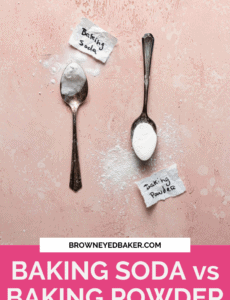
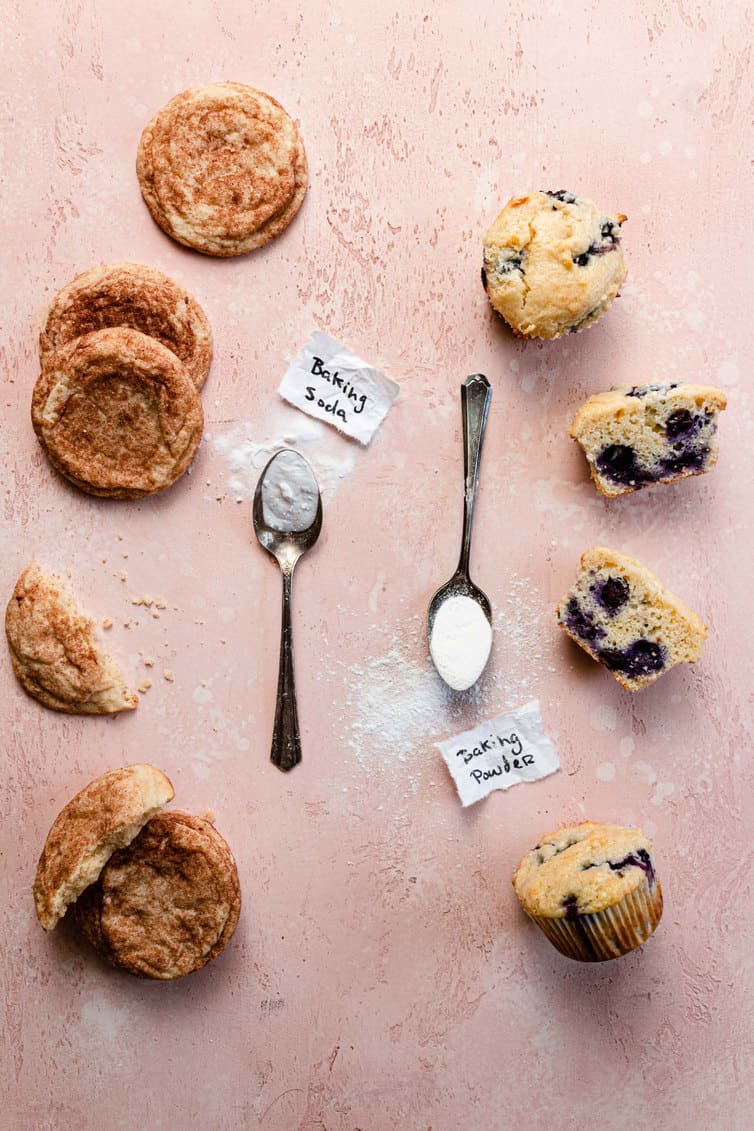
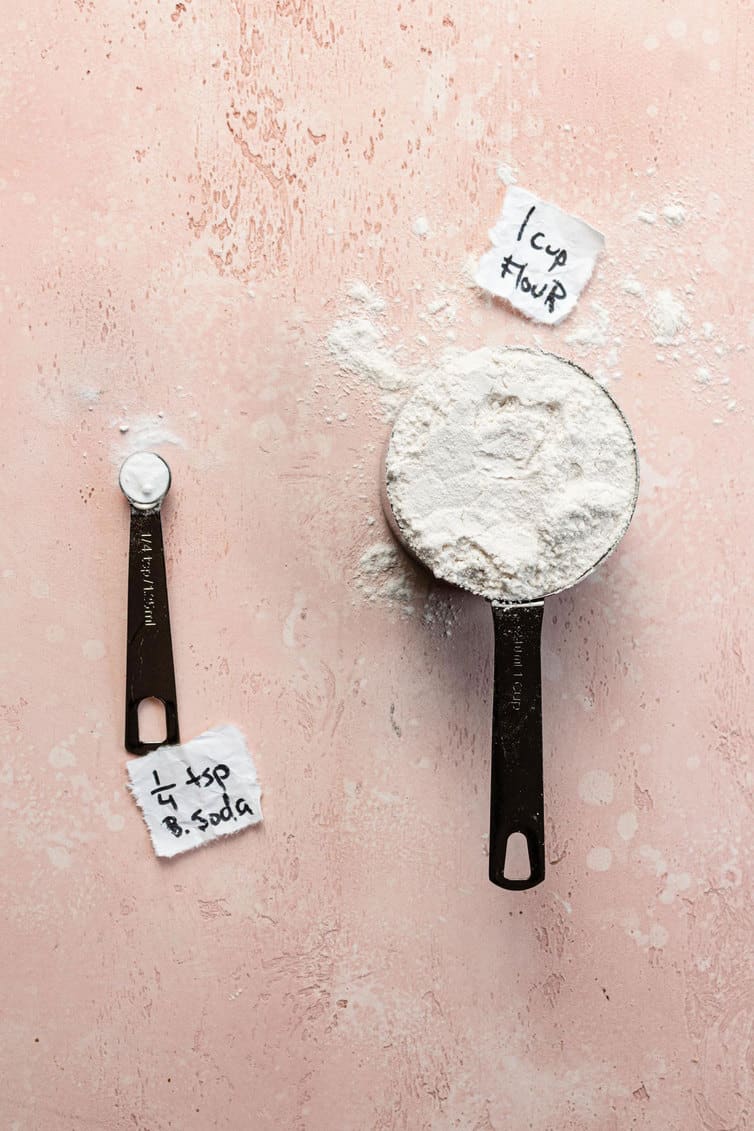
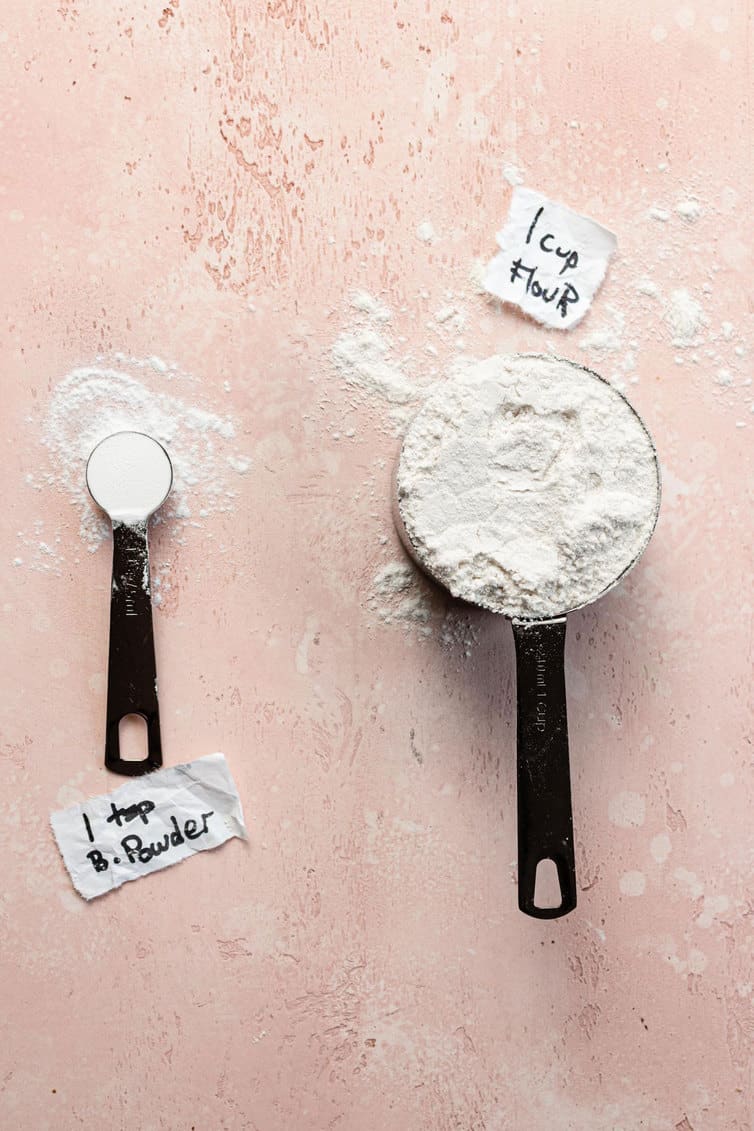
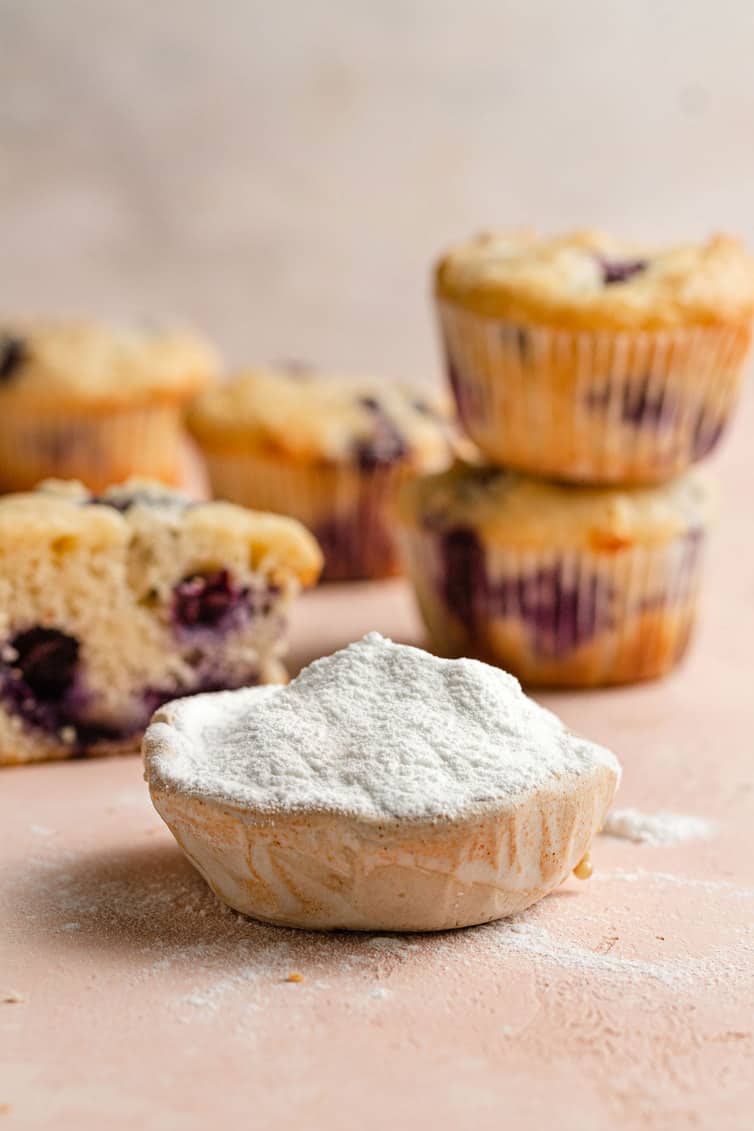
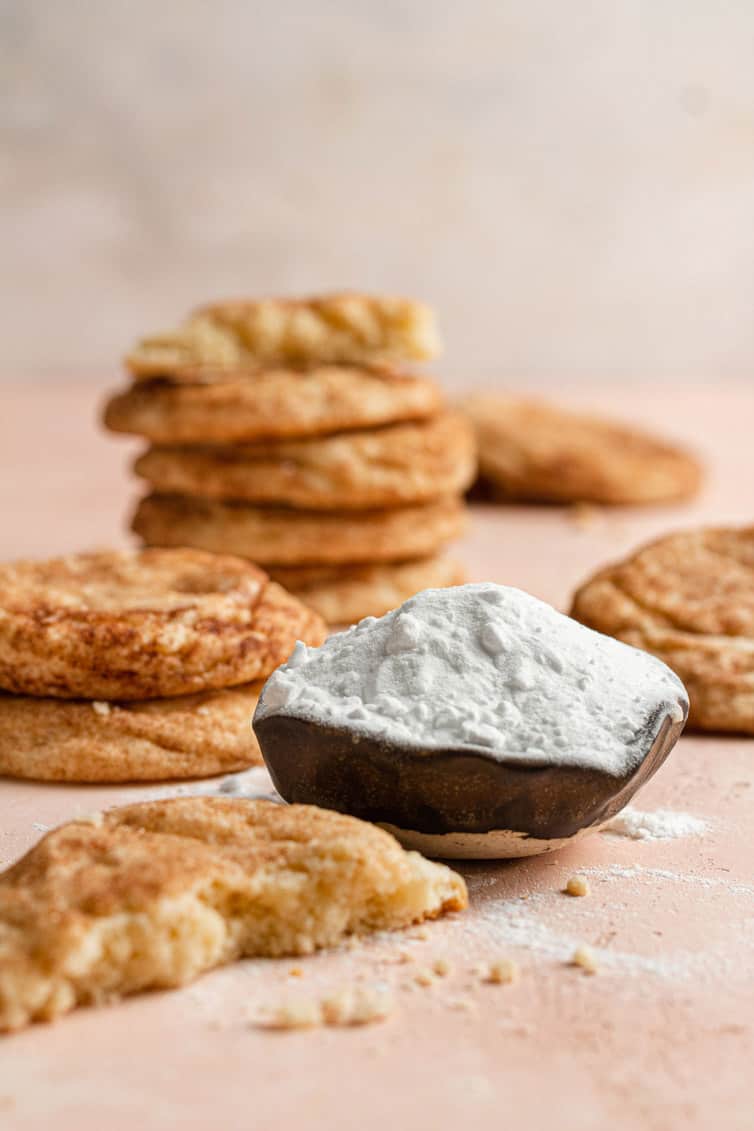
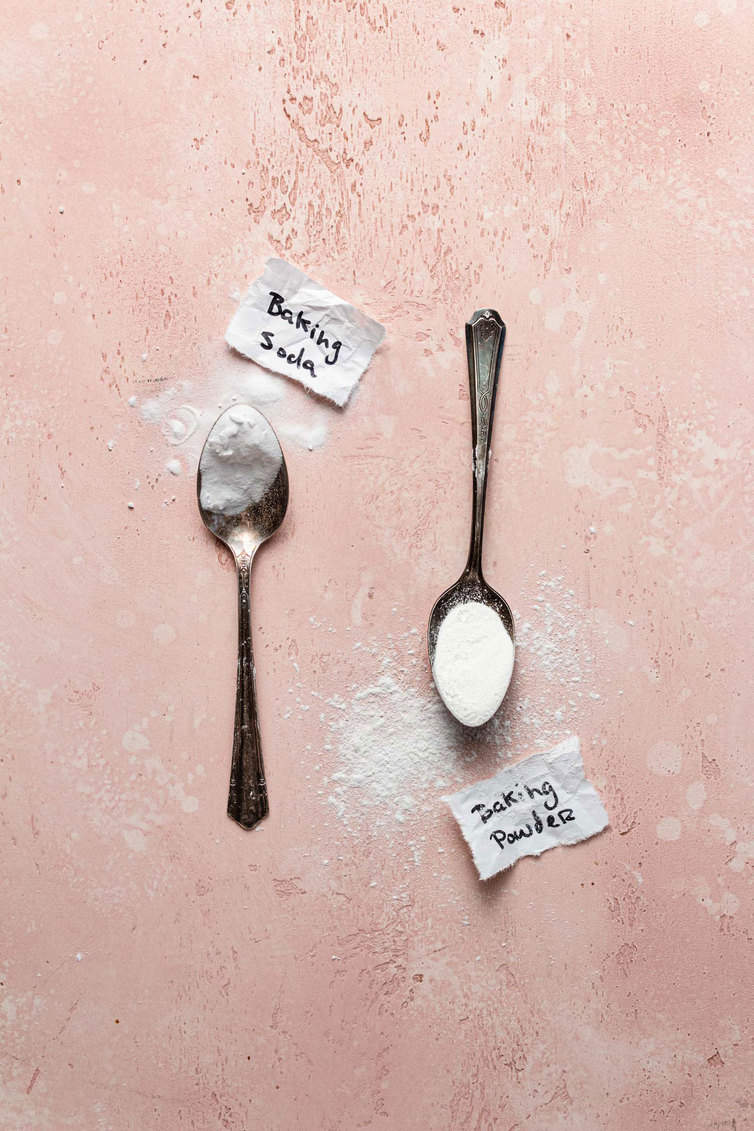



I have a Ricotta Apple Cake recipe that uses 2 cups flour.
I’m subbing in brown sugar for white, cooled melted butter for oil.
The original recipe calls for 1 T baking powder but it’s too much.
Any advice on the bp?
until now I am still confused about which baking soda and baking powder are. but, thanks for sharing this great information :)
What is the best way to keep baking soda fresh? Only the large bag comes resealable but I don’t make a dent in that large bag if I need to replace it every three months. At least the baking powder comes with a sealable lid. Thank you for the information! Super helpful!
Hi Beth, You definitely don’t need to replace every 3 months, that’s just a heads up in case you’re having issues with your baked goods, you may want to check to ensure the leaveners are still fresh. If you use the bag and it’s resealable, I think that’s fine. If you buy the cardboard box, I would transfer to any airtight container. Hope that helps!
I have always wondered what the difference between baking soda and baking powder is. Thank you for this article, I loved it!
Thanks! That was very interesting and really helpful!
Thanks for this article. Been baking for years but learned some helpful ideas. Proves you can teach an old dog new tricks.
I’m at least an intermediate in terms of baking experience, but I learned so much from this post! Thanks!!
Oh my gosh, that’s wonderful!! I’m so glad you found it helpful!!
Thank you for this! I have read so many articles on the difference of the two and this is the first time I fully understand it. THANK YOU, THANK YOU, THANK YOU!!! You made this so easy to understand and with added information on how to check freshness and how to substitute. Everything I need to know on the two in one place.
Aw, I am so thrilled to hear that! I’m so happy that you found this so useful!
Absolutely love this post! So helpful and informative!
So happy you found it helpful, Amy!
Thank you! This is super helpful😊
You’re welcome, Macy!
Have often wondered about the difference! Thanks for sharing the info.
Will baking soda that does not meet the “fresh” test still help with odors in your refrigerator?
You’re welcome, Hope! I am actually not sure about the fridge; I think the “official” recommendation is to change those boxes out once a month.
THANK YOU SO MUCH!!! I have been wondering about baking soda for a while now! It is never used in french baking so it always felt weird and useless to me. Most of the time, I would juste replace it with baking power. Now I understand and I make the effort of using to! ;-))
Also I understand now why it gives this metallic taste sometimes: not enough acid!
I love this kind of articles so please keep it coming!
I don’t think you’ve done one about cookies yet but that would be great: how to get different effects (chewy, crispy) by tweaking ingredients.
Loved this lesson! Especially including how to test if my current supply is fresh! Thank you
You’re welcome! I’m so glad you found it useful!
Hi, just about to print this of for a friend, she’s always phoning me about this. Thank for putting this up on here.
You’re welcome! I hope your friend finds it helpful!
Double-acting baking powder has a second base in it which doesn’t react with acid at room temperature. It doesn’t start to react until about 150-160F (i.e. once your baked good is in the oven). That’s why you need to test baking powder in hot water (and tap water usually isn’t hot enough).
WOW. I have been baking for YEARS and have NEVER had these two ingredients explained so completely to me. This is amazing information to share. Thank you so much for this post!
Hi there!
If you’re scaling up a recipe, let’s say from a 6″ pan to a 10″ pan, how much chemical leavener do you use? The amount of baking powder/soda needs to decrease if the pan size increases, right?
Hi Samantha, I’m not sure about that… anytime I increase a recipe, I increase the leaveners as well, not decrease.
I think what OP means is that you may increase the leavener by less than you expect. Doubling the batch does not always mean doubling the leavener. This is more true of yeast than chemical leaveners. I usually look at the surface area of my pans – if I’m going from an 8×8″ (64 sq in) to a 9×13″ (117 sq in), I’ll double everything but the leavener; I’ll multiply the leavener by 1.8 (117/64 = 1.82). MOST of the time, at home pan sizes, there isn’t enough of a difference to matter – the difference between 1 3/4 tsp and 2 tsp is mostly trivial.
Two things:
(1) I’ve read these discussions before, but I’m still confused about why exactly we use an acid with baking soda: Is it (a) bases need acids to react or (b) baking soda reacts by itself but needs an acid to neutralize the metallic flavor? I’ve seen both, but I don’t understand how they’re not mutually exclusive.
(2) If I want to develop a recipe from scratch, do you have any suggested amounts of baking soda for acids? Like, for X amount of light brown sugar, you should use X amount of baking soda?
Hi Avra, (1) It’s both. The baking soda will react to the heat, but not enough to appropriately leaven the recipe, which is where the acidic ingredient comes in. (2) I’m not sure that there’s a hard and fast rule, as it would depend on all of the other ingredients in the recipe and how they balance each other out (liquids, eggs, etc.)
Baking soda can be both an acid and a base – the bicarbonate ion can give up a hydrogen ion to become carbonate, or it can accept a hydrogen ion to become carbon dioxide and water. We add extra acid to drive the reaction towards producing CO2; without it, either some of the bicarbonate becomes carbonate, which tastes metallic, or the bicarbonate steals hydrogen from water, leaving behind hydroxide ions, which taste soapy.
Michelle, just a note of thanks for this great series. Baking soda vs baking powder – oof! Thank you for solving this mystery for us in such an easily understandable way! I’ve seen other bloggers have a go at this topic, but you seem to understand THE BEST just how much we need to know, and are great at consolidating the science into laymen’s terms. THANK YOU!
The thing is, baking soda is not really available in Germany (well, if you do some searching and digging, it probably is, but it’s hard to find) while baking powder is all over the place. That’s why I always switch them out. :/
Hi Rachel, the correct German product is Natron, available in most grocery stores (but not in Aldi or Lidl).
Liebe Grüße, Betti
For baking soda you say letting the item sit decreases the leavening effect, but many chocolate chip cookie recipes call for baking soda and they suggest letting the dough sit in the fridge for 72 hours before baking to prevent spreading and give MORE lift. What’s the deal there? :)
Not the author but I figure it might be because cookie dough doesn’t typically contain watery liquids but rather lots of fat and only maybe an egg. Not an expert but believe this would make a difference.
Hi Lisa, The chocolate chip cookie recipes that I have used calling for refrigeration call for both baking soda and baking powder, so they fall into that both category, which makes the dough more stable for refrigeration.
Those recipes will typically call for both baking soda and baking powder. The baking powder provides lift; the baking soda is there for browning.
To take this one step further…most baking powder has aluminum In it. I can taste it if there is more than 1 tsp. Learned a long time ago that the baking powder of choice is RUMFORD…no aluminum and used by most of the professional chefs
Sorry to differ, but baking soda is alkaline…the exact opposite of acid. Adding acid to acid does nothing to create leavening (bubbles). Adding an alkaline substance to an acidic batter is what causes the reaction.
Thank you Lori. I too heard the fingernails on the blackbord when I read that.
Hi Lori, Yes, I used the term base (same as alkaline), which is why it is typically paired with an acid in recipes.
What’s the deal on baking powder with or without aluminum? Do you have a preference? Thanks, Michelle.
Hi Joan, Here’s the scoop… Aluminum-free baking powders are only single-acting, which means they react with liquid, and not necessarily with heat. So you cannot make anything ahead of time with aluminum-free baking powder or you will risk not having it rise in the oven. Some people say that they can taste a bitter or metallic off-taste when using traditional baking powder with aluminum. It’s really personal preference, just know that if you use aluminum-free, you’ll want to get it in the oven ASAP after mixing up the batter or dough!
I just LOVE this baking series ! In school I was a bit of a science geek girl and I think that explains why I’d much rather bake a cake or throw together a quick bread than cooking supper on the stove.
Baking is such a science……and sometimes an experiment……if you’ve realized you left out an important ingredient.!
Thank you so much for the info. and just wanted to say I really appreciate this baking series. The science of baking is SO important and fascinating.
Keep up the good work, we appreciate it.
Thanks so much for these baking installments! I’ve been trying to teach myself to bake and these have been extremely useful. :)
Thank you for all the information on cocoa and baking soda and baking powder. I really enjoy your blog and have made numerous recipes.
Thanks for publishing this article. I knew quite a bit already, but still learnt quite a lot. Nice concise style, perfect for a retired engineer like me! Also liked where you explained precisely how much of each to use and when.
Thanks again.
Grazie ,ottimo post,tanti chiarimenti utili,buona giornata